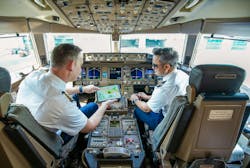Tracking Turbulence: Emirates Joins Turbulence Aware Platform
Emirates is using tools to detect and navigate turbulence. The airline announced on May 30 that it has joined the 20 airlines participating in the International Air Transport Association’s (IATA’s) Turbulence Aware Platform. Emirates, however, will be the first airline to navigate the platform within the latest version of Lido mPilot, a navigation solution from Lufthansa Systems.
The announcement from Emirates came days after one person died and dozens were injured due to severe turbulence on Singapore Airlines Flight SQ321.
According to the National Transportation Safety Board, "Turbulence-related accidents are the most common type of accident involving air carriers operating under Title 14 Code of Federal Regulations Part 121."
By bringing the Turbulence Aware Platform together with the mobile navigation solution, Emirates pilots will have up-to-the-minute, highly accurate turbulence information and forecasts. This data will help plot the best paths around affected areas.
“Actively participating in IATA’s Turbulence Aware platform and equipping our pilots with a complement of the latest industry technologies such as the mobile navigation solution Lido mPilot from Lufthansa Systems are part of our commitment to ensure operational safety, efficiency and customer comfort on every flight,” said Capt. Hassan Alhammadi, divisional senior vice president, Flight Operations Emirates Airline.
“We’re also proud to contribute data around turbulence through our Middle East network and extensive links across Africa, Asia, Australia and other regions,” Alhammadi continued. “It will help build sophisticated industry knowledge to effectively manage turbulence and evolving weather patterns with even more precision. This is only the beginning, and we are progressing with plans to integrate more cutting-edge technologies to elevate the flying experience even further, so our customers can enjoy smoother journeys.”
Emirates has equipped more than 140 aircraft with the required onboard software to automatically share turbulence reports with all airlines contributing data to the Turbulence Aware Platform.
IATA in June 2023 said, "At present, 20 airlines participate in the IATA Turbulence Aware Platform with more than 1,900 aircraft providing data daily. In 2022, a total of 31 million reports were generated."
Over the course of the next few years, all new aircraft joining Emirates’ fleet will be equipped with the technology.
“Mitigating the adverse effects of turbulence is an industrywide challenge and obtaining accurate and live data is key in this endeavor. The cooperation between IATA Turbulence Aware, Emirates and Lufthansa Systems will further improve the quality and quantity of real-time data made available to the industry, allowing for smoother and safer air travel for all,” said Frederic Leger, IATA’s senior vice president commercial products and services.
What is Lido mPilot?
Lido mPilot is an all-in-one mobile navigational charting application from Lufthansa Systems and is configured based on specific operational requirements. Lido mPilot provides pilots with easy access to terminal charts, a dynamically generated enroute map, and an Airport Moving Map (AMM). Its data-driven, interactive maps, and the latest weather features relevant to each flight being operated ensure enhanced situational awareness and the most pertinent information for pilots.
How does IATA Turbulence Aware data enhance the value of Lido mPilot?
“IATA Turbulence Aware data enhances the value of Lido mPilot by providing pilots with real-time, accurate and comprehensive information on turbulence, enabling them to make informed decisions and navigate more efficiently. By integrating this data into Lido mPilot, Emirates Airline can increase safety, reduce fuel consumption and minimize passenger discomfort, ultimately improving their operational efficiency and customer satisfaction,” said Andreas Medlhammer, Product Owner Pilot Charting Apps at Lufthansa Systems.
What is Turbulence Aware?
IATA’s Turbulence Aware is a global, real-time detailed and objective information resource for pilots and aviation professionals to manage and mitigate the impact of turbulence on operations. Turbulence is the main cause of passenger and crew injuries and leads to higher fuel usage. The platform pools anonymized turbulence data from thousands of flights operated around the world. The information generated from this data enables pilots and dispatchers to choose optimal flight paths, avoiding turbulence and flying at peak levels and altitudes to maximize fuel efficiency, ultimately reducing carbon emissions. To date, IATA says Turbulence Aware ensured a safer flight for over 700 million passengers, a number that will continue to rise as new airlines join the program.
What Happened on Flight SQ321?
A Boeing 777-300ER was flying from London to Singapore and diverted to Bangkok on May 20. Transport Safety Investigation Bureau (TSIB) of Singapore issued preliminary investigation findings on May 29. Among the findings, “The rapid changes in gravitational force over the 4.6 sec duration resulted in an altitude drop of 178 feet, from 37,362 feet to 37,184 feet. This sequence of events likely caused the injuries to the crew and passengers.” The investigation team includes TSIB investigators and United States representatives from the National Transportation Safety Board (NTSB), Federal Aviation Administration (FAA) and Boeing.
About the Author
Rebecca Kanable
Assistant Editor
Rebecca Kanable, a veteran journalist, worked with Endeavor Business Media's aviation group from 2021 to 2024 as assistant editor of Airport Business, AMT and Ground Support Worldwide. She previously worked for various publications, including trade magazines and newspapers.

